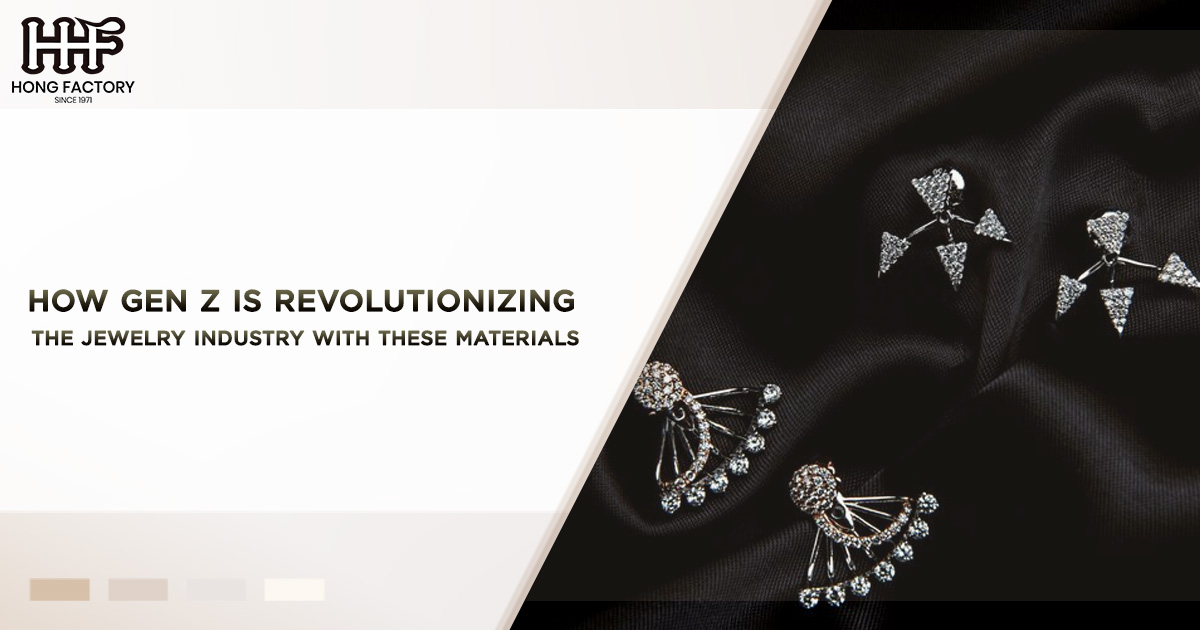The jewelry industry is undergoing a profound transformation, thanks to the influence of Gen Z. Often described as the most eco-conscious and socially aware generation to date, Gen Z is redefining what it means to create, purchase, and wear jewelry. Their priorities—rooted in sustainability, innovation, and individuality—are driving a paradigm shift in the ways jewelry is designed and produced. By embracing sustainable materials and pushing for more innovative jewelry designs, Gen Z is shaping the future of fashion and challenging traditional industry norms.
This article explores how youth trends and eco-conscious values are revolutionizing the jewelry industry, with a special focus on the materials and practices that are capturing the hearts and wallets of this influential generation.
The Rise of Eco-Conscious Jewelry
Gen Z has grown up in an era defined by climate change awareness, social justice movements, and the demand for corporate accountability. As a result, their purchasing behavior reflects a deep commitment to sustainability and ethical practices. In the jewelry industry, this has translated into a growing preference for eco-conscious materials and processes.
What Are Sustainable Materials ?
Sustainable materials in jewelry refer to resources that are responsibly sourced, environmentally friendly, and often recycled or upcycled. These materials aim to reduce the environmental footprint of jewelry production while ensuring fair labor practices.
Some of the most popular sustainable materials among Gen Z include
- Recycled metals: Gold, silver, and platinum that have been repurposed from old jewelry, electronics, or industrial waste.
- Lab-grown diamonds: Ethically produced diamonds that mimic natural ones without the environmental and social issues tied to traditional mining.
- Alternative gemstones: Man-made or naturally abundant stones, such as moissanite or quartz, which offer a sustainable and affordable alternative to mined gems.
- Biodegradable materials: Innovations like plant-based resins or organic materials such as wood, shells, and seeds.
- Recycled plastics: Jewelry made from repurposed ocean plastics or post-consumer waste, combining style with environmental activism.
Youth Trends Driving Change in the Jewelry Industry
Gen Z’s fascination with sustainability goes beyond materials—it’s reshaping the entire industry, from design to marketing. Let’s analyze the youth trends that are fueling this revolution.
1. Personalization and Storytelling
Unlike previous generations, Gen Z prioritizes individuality over conformity. They seek out jewelry that tells a story, reflects their values, or carries personal significance. This has led to a surge in demand for one-of-a-kind, customized, or small-batch jewelry pieces.
Brands are responding by offering collections that are not only sustainable but also deeply personal. For example, some companies allow customers to repurpose heirloom jewelry into modern designs, preserving sentimental value while embracing sustainable practices.
2. Transparency and Ethical Sourcing
Gen Z demands transparency from brands, particularly when it comes to sourcing materials. They want to know where their jewelry comes from, how it’s made, and who is making it. This has pushed many companies to adopt ethical sourcing practices and share detailed information about their supply chains.
Brands that fail to address issues such as conflict diamonds, exploitative labor, or environmental harm risk losing Gen Z’s trust. On the other hand, brands that embrace certifications like Fair Trade or align themselves with sustainable initiatives gain credibility and loyalty among young consumers.
3. Affordability Meets Sustainability
While Gen Z is committed to sustainability, they are also a pragmatic generation, often limited by student loans or entry-level incomes. This has created a growing market for affordable, sustainable jewelry.
Lab-grown diamonds and recycled metals have emerged as perfect solutions, offering both ethical value and cost-effectiveness. Additionally, many Gen Z consumers are turning to smaller, independent brands that prioritize sustainability but keep prices accessible.
Innovative Jewelry – Where Sustainability Meets Creativity
One of the most exciting aspects of Gen Z’s influence is the rise of innovative jewelry. Young consumers are drawn to bold, futuristic designs that blend sustainability with cutting-edge technology. Let’s explore some examples:
1. 3D-Printed Jewelry
3D printing technology has revolutionized how jewelry is made, allowing for intricate designs that would be impossible with traditional methods. This process also minimizes waste, as it uses only the exact amount of material needed.
Forward-thinking brands are using 3D printing to create avant-garde pieces from sustainable materials like recycled metals or biodegradable plastics. These designs appeal to Gen Z’s love of innovation and individuality.
2. Wearable Technology
As digital natives, Gen Z is naturally drawn to tech-infused jewelry. From rings that track your fitness to necklaces that double as phone chargers, wearable technology is transforming jewelry into multifunctional accessories.
Sustainability plays a role here, too. Many tech-focused jewelry brands are incorporating eco-conscious fashion and designing products to be repairable or recyclable, aligning with Gen Z’s values.
3. Biodegradable and Natural Elements
The use of natural and biodegradable materials is a growing trend in innovative jewelry. Designers are experimenting with plant-based resins, recycled wood, and even algae to create sustainable yet stylish pieces.
For example, some brands are crafting jewelry from ocean plastics, turning environmental pollutants into wearable art. This not only appeals to Gen Z’s eco-conscious fashion but also allows them to make a statement about environmental activism through their fashion choices.
How Brands Are Adapting
The shift toward sustainable and innovative jewelry has forced traditional brands to evolve. Large-scale companies are investing in green initiatives, while startups are entering the market with sustainability as their core value.
Marketing to Gen Z
To capture the attention of Gen Z, jewelry brands are leveraging social media platforms like TikTok and Instagram. These platforms allow brands to showcase their eco-conscious practices, innovative designs, and compelling stories in a visually engaging way. User-generated content, influencer collaborations, and behind-the-scenes videos have become powerful tools for building trust and authenticity.
Circular Economy Initiatives
Another strategy gaining traction is the circular economy model. Brands are encouraging customers to trade in old jewelry for store credit, which is then melted down and repurposed into new designs. This not only reduces waste but also fosters brand loyalty.
The Future of Fashion and Jewelry
As Gen Z continues to influence the jewelry industry, we can expect sustainability and innovation to remain at the forefront. Future trends may include even more advanced materials, such as lab-grown metals or bioengineered gemstones, as well as greater integration of technology into jewelry design.
Moreover, the emphasis on ethical practices and transparency will likely become industry standards, thanks to the pressure exerted by Gen Z and other eco-conscious consumers.
Conclusion
Gen Z’s impact on the jewelry industry is undeniable. Through their commitment to sustainable materials, innovative designs, and ethical practices, they are reshaping the way jewelry is made, marketed, and consumed. This generation’s focus on individuality and eco-consciousness is not only driving youth trends but also setting a new standard for fashion as a whole.
As more brands adapt to meet these demands, the jewelry industry has a unique opportunity to align beauty with responsibility, creativity with sustainability, and tradition with innovation. Ultimately, Gen Z is proving that fashion can be a force for positive change—and they’re doing it with style.




